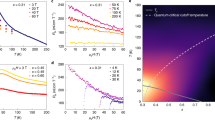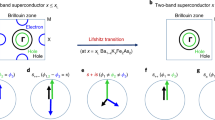Abstract
Applied magnetic fields underlie exotic quantum states, such as the fractional quantum Hall effect1 and Bose–Einstein condensation of spin excitations2. Superconductivity, however, is inherently antagonistic towards magnetic fields. Only in rare cases3,4,5 can these effects be mitigated over limited fields, leading to re-entrant superconductivity. Here, we report the coexistence of multiple high-field re-entrant superconducting phases in the spin-triplet superconductor UTe2 (ref. 6). We observe superconductivity in the highest magnetic field range identified for any re-entrant superconductor, beyond 65 T. Although the stability of superconductivity in these high magnetic fields challenges current theoretical models, these extreme properties seem to reflect a new kind of exotic superconductivity rooted in magnetic fluctuations7 and boosted by a quantum dimensional crossover8.
This is a preview of subscription content, access via your institution
Access options
Access Nature and 54 other Nature Portfolio journals
Get Nature+, our best-value online-access subscription
$29.99 / 30 days
cancel any time
Subscribe to this journal
Receive 12 print issues and online access
$209.00 per year
only $17.42 per issue
Buy this article
- Purchase on Springer Link
- Instant access to full article PDF
Prices may be subject to local taxes which are calculated during checkout




Similar content being viewed by others
References
Stormer, H. L. Nobel lecture: the fractional quantum Hall effect. Rev. Mod. Phys. 71, 875–889 (1999).
Zapf, V., Jaime, M. & Batista, C. D. Bose–Einstein condensation in quantum magnets. Rev. Mod. Phys. 86, 563–614 (2014).
Meul, H. W. et al. Observation of magnetic-field-induced superconductivity. Phys. Rev. Lett. 53, 497–500 (1984).
Uji, S. et al. Magnetic-field-induced superconductivity in a two-dimensional organic conductor. Nature 410, 908–910 (2001).
Konoike, T. et al. Magnetic-field-induced superconductivity in the antiferromagnetic organic superconductor κ−(BETS)2FeBr4. Phys. Rev. B 70, 094514 (2004).
Ran, S. et al. Nearly ferromagnetic spin-triplet superconductivity. Science 365, 684–687 (2019).
Mineev, V. P. Reentrant superconductivity in URhGe. Phys. Rev. B 91, 014506 (2015).
Lebed, A. G. & Sepper, O. Quantum limit in a magnetic field for triplet superconductivity in a quasi-one-dimensional conductor. Phys. Rev. B 90, 024510 (2014).
Jaccarino, V. & Peter, M. Ultra-high-field superconductivity. Phys. Rev. Lett. 9, 290–292 (1962).
Lévy, F., Sheikin, I., Grenier, B. & Huxley, A. D. Magnetic field-induced superconductivity in the ferromagnet URhGe. Science 309, 1343–1346 (2005).
Lévy, F., Sheikin, I. & Huxley, A. Acute enhancement of the upper critical field for superconductivity approaching a quantum critical point in URhGe. Nat. Phys. 3, 460–463 (2007).
Aoki, D. et al. Unconventional superconductivity in heavy fermion UTe2. J. Phys. Soc. Jpn 88, 043702 (2019).
Aoki, D. et al. Extremely large and anisotropic upper critical field and the ferromagnetic instability in UCoGe. J. Phys. Soc. Jpn 78, 113709 (2009).
Huxley, A. D., Yates, S. J. C., Lévy, F. & Sheikin, I. Odd-parity superconductivity and the ferromagnetic quantum critical point. J. Phys. Soc. Jpn 76, 051011 (2007).
Hattori, T. et al. Relationship between ferromagnetic criticality and the enhancement of superconductivity induced by transverse magnetic fields in UCoGe. J. Phys. Soc. Jpn 83, 073708 (2014).
Knafo, W. et al. High-field moment polarization in the ferromagnetic superconductor UCoGe. Phys. Rev. B 86, 184416 (2012).
De Boer, F. R. et al. High-magnetic-field and high-pressure effects in monocrystalline URu2Si2. Phys. B+C. 138, 1–6 (1986).
Balicas, L. et al. Superconductivity in an organic insulator at very high magnetic fields. Phys. Rev. Lett. 87, 067002 (2001).
Hattori, K. & Tsunetsugu, H. p-Wave superconductivity near a transverse saturation field. Phys. Rev. B 87, 064501 (2013).
Sherkunov, Y., Chubukov, A. V. & Betouras, J. J. Effects of Lifshitz transitions in ferromagnetic superconductors: the case of URhGe. Phys. Rev. Lett. 121, 097001 (2018).
Dupuis, N. & Montambaux, G. Superconductivity of quasi-one-dimensional conductors in a high magnetic field. Phys. Rev. B 49, 8993–9008 (1994).
Sato, M. & Ando, Y. Topological superconductors: a review. Rep. Prog. Phys. 80, 076501 (2017).
Kallin, C. & Berlinsky, J. Chiral superconductors. Rep. Prog. Phys. 79, 054502 (2016).
Sarma, S. D., Freedman, M. & Nayak, C. Majorana zero modes and topological quantum computation. npj Quant. Inf. 1, 15001 (2015).
Karzig, T. et al. Scalable designs for quasiparticle-poisoning-protected topological quantum computation with Majorana zero modes. Phys. Rev. B 95, 235305 (2017).
Miyake, A. et al. Metamagnetic transition in heavy fermion superconductor UTe2. J. Phys. Soc. Jpn 88, 063706 (2019).
Knebel, G. et al. Field-reentrant superconductivity close to a metamagnetic transition in the heavy-fermion superconductor UTe2. J. Phys. Soc. Jpn 88, 063707 (2019).
Palm, E. C. & Murphy, T. P. Very low friction rotator for use at low temperatures and high magnetic fields. Rev. Sci. Instrum. 70, 237–239 (1999).
Altarawneh, M. M., Mielke, C. H. & Brooks, J. S. Proximity detector circuits: an alternative to tunnel diode oscillators for contactless measurements in pulsed magnetic field environments. Rev. Sci. Instrum. 80, 066104 (2009).
Ghannadzadeh, S. et al. Measurement of magnetic susceptibility in pulsed magnetic fields using a proximity detector oscillator. Rev. Sci. Instrum. 82, 113902 (2011).
Singleton, J. et al. Observation of the Fulde–Ferrell–Larkin–Ovchinnikov state in the quasi-two-dimensional organic superconductor κ–(BEDT–TTF)2Cu(NCS)2. J. Phys. Condens. Matter 12, L641 (2000).
Goddard, P. A. et al. Experimentally determining the exchange parameters of quasi-two-dimensional Heisenberg magnets. New J. Phys. 10, 083025 (2008).
Acknowledgements
We acknowledge helpful discussions with A. Lebed and V. Yakovenko. W.T.F. is grateful for the support of the Schmidt Science Fellows programme in partnership with the Rhodes Trust. Research at the University of Maryland was supported by the US National Science Foundation Division of Materials Research Award No. DMR-1610349 (support for sample preparation), the US Department of Energy (DOE) Award No. DE-SC-0019154 (support for experimental measurements) and the Gordon and Betty Moore Foundation’s EPiQS Initiative through Grant No. GBMF4419 (support for materials synthesis). Work performed at NHMFL was supported by NSF Cooperative Agreement No. DMR-1644779, the State of Florida, DOE and through the DOE Basic Energy Sciences Field Work Project Science in 100 T. A portion of this work was supported by the NHMFL User Collaboration Grants Program. Identification of commercial equipment does not imply recommendation or endorsement by NIST.
Author information
Authors and Affiliations
Contributions
N.P.B. directed the project. S.R., W.T.F. and S.R.S. synthesized the single crystalline samples. S.R., I.-L.L., J.S. and F.B. performed the magnetoresistance, PDO and magnetization measurements in the pulsed field. Y.S.E., D.J.C., P.M.N. and D.G. performed the magnetoresistance measurements in the d.c. field. C.E. and H.K. performed magnetoresistance measurements in low magnetic fields. S.R. and N.P.B. wrote the manuscript with contributions from all authors.
Corresponding authors
Ethics declarations
Competing interests
The authors declare no competing interests.
Additional information
Publisher’s note Springer Nature remains neutral with regard to jurisdictional claims in published maps and institutional affiliations.
Supplementary information
Supplementary Information
Supplementary Figs. 1–5.
Supplementary Data 1
Source data for Fig. 1.
Supplementary Data 2
Source data for Fig. 2.
Supplementary Data 3
Source data for Fig. 3.
Supplementary Data 4
Source data for Fig. 4.
Rights and permissions
About this article
Cite this article
Ran, S., Liu, IL., Eo, Y.S. et al. Extreme magnetic field-boosted superconductivity. Nat. Phys. 15, 1250–1254 (2019). https://doi.org/10.1038/s41567-019-0670-x
Received:
Accepted:
Published:
Issue Date:
DOI: https://doi.org/10.1038/s41567-019-0670-x
This article is cited by
-
Melting of the charge density wave by generation of pairs of topological defects in UTe2
Nature Physics (2024)
-
Quasi-2D Fermi surface in the anomalous superconductor UTe2
Nature Communications (2024)
-
Orphan high field superconductivity in non-superconducting uranium ditelluride
Nature Communications (2024)
-
Field-induced compensation of magnetic exchange as the possible origin of reentrant superconductivity in UTe2
Nature Communications (2024)
-
Chiral superconductivity in UTe2 probed by anisotropic low-energy excitations
Nature Communications (2023)



